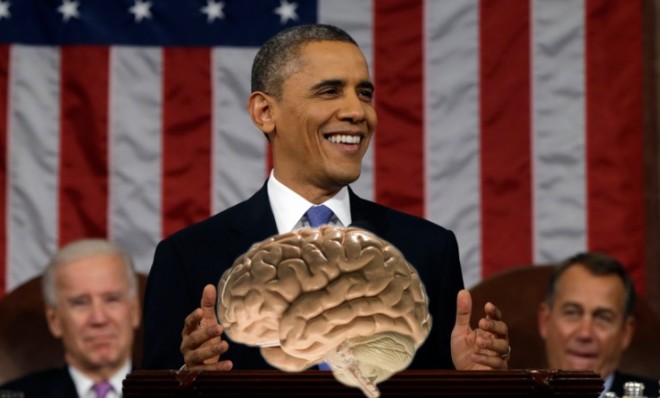Why Obama wants to map the human brain
The White House is set to reveal an ambitious, groundbreaking plan to unravel the inner-workings of the mind

Of all the ideas mentioned in President Obama's State of the Union address last week, one that stood out against the rest was his mention of an ambitious plan to roadmap the entirety of the human brain — the mysterious, messy tangle of neurons and synapses firing between your ears this very second.
"Every dollar we invested to map the human genome returned $140 to our economy — every dollar," said Obama, referring to the decades-long Human Genome Project, a groundbreaking international effort to map our DNA, which this new project is being silhouetted against. "Today our scientists are mapping the human brain to unlock the answers to Alzheimer's. They're developing drugs to regenerate damaged organs, devising new materials to make batteries 10 times more powerful. Now is not the time to gut these job-creating investments in science and innovation."
Following up on Obama's statement, The New York Times reports that in the coming months, the White House will announce the Brain Activity Map Project, an unprecedented, federally funded, multi-billion-dollar effort to unravel the inner-workings of Mother Nature's most powerful processor. The initiative will be spearheaded by the Office of Science and Technology Policy, with support from the National Institutes of Health and other government agencies. Officials are hoping to tap into a network of neuroscientists from top-tier institutions from all over the world to focus on a singular, decade-and-a-half goal: To build the first-ever working model of the mind.
The Week
Escape your echo chamber. Get the facts behind the news, plus analysis from multiple perspectives.

Sign up for The Week's Free Newsletters
From our morning news briefing to a weekly Good News Newsletter, get the best of The Week delivered directly to your inbox.
From our morning news briefing to a weekly Good News Newsletter, get the best of The Week delivered directly to your inbox.
The case for mapping the brain
Hints of the BAM project first surfaced last June in the journal Neuron, when Harvard geneticist George Church first proposed a plan to illustrate the brain's little-understood but vast architecture, which, of course, is expensive. "We can bring down the cost and increase the quality of the technology," Church tells NBC News. "We are trying to work with current funding [levels] to bring down the cost." The federal government's proposed 15-year effort would inject some $3 billion into global neuroscience research, with the aim to lower the cost of existing technologies and pioneer new techniques that allow us to get a closer, deeper look into the brain at a molecular level. Constructing a fully functional model with every neural pathway and action meticulously documented could allow researchers from far-reaching scientific fields to treat neurodegenerative diseases like Parkinson's, Alzheimer's, and schizophrenia; develop faster, more efficient supercomputers; and, if we're lucky, perhaps even jolt the economy with a lucrative return on its investment, much like the Human Genome Project mentioned in Obama's speech.
How they'll do it
Mapping the brain, of course, isn't easy — if it were, we would've done it by now. Church and his comrades insist that such a task wouldn't start with human heads, but rather with the brains of lab mice before working our way up to apes. Tracing the brain's advanced circuitry can be accomplished a few ways, with different research institutions divvying up the workload: Traditional magnetic resonance imaging (MRIs), wireless fiber-optic brain implants, and even attaching genetically engineered tracer cells to existing brain cells, like a Google driverless car for your brain's highways.
A free daily email with the biggest news stories of the day – and the best features from TheWeek.com
Eliminating disease
Writing for this website in November, Bill Frist called on the eventual president to wage a war on Alzheimer's, the crippling brain disease that affects 1 in 8 Americans. "It is a demographically driven, rapidly expanding condition that is incurable and fatal," he said. "It wrenches apart families emotionally and economically. And it will, if not reversed, inevitably affect every family." The origins of Alzheimer's, like many other degenerative disorders, are still largely a mystery. Its symptoms can severely affect a person's twilight years, robbing them of their memory, perception, language, and cognitive skills. Understanding how the brain's roughly 100 billion neurons travel — or more specifically, learning where damaging traffic pile-ups happen — could offer scientists valuable insight into new treatments. "Not least, we might expect novel understanding and therapies for diseases like schizophrenia and autism," wrote the BAM proposal's scientists.
Smarter computers
Futurists like Ray Kurzweil, author of How to Create a Mind, have been interested in reverse-engineering the brain for a long time. It's easy to see how understanding the brain's mechanics could lead to more powerful supercomputers, especially since we've already figured out how to effectively transform strands of DNA into hard drives. Imagine: Artificial intelligence trouncing the speed and accuracy of IBM's Watson. Desktop PCs that can efficiently code solutions to their own problems. It's not a question of if, at this point, but a matter of when.
And it isn't just our machines that will receive a processing boost. "Knowing how the human brain works means that we will, at some point in the near future, be able to fundamentally change the structure of it by re-arranging a few neural pathways," says Domnic Basulto at The Washington Post. "If we understand how memory works, we may be able to download new memories into our brains. If we understand how language processing works, we may be able to insert foreign language knowledge into our brains just like a series of software upgrades."
A question of legacy
The big question now is: Why would Obama spring for such an initiative? The Washington Post's Basulto says it won't be to create jobs, and he wonders if it's something of a legacy play. "In much the same way that the JFK presidency has become known as the one that sent our nation to the moon, will the Obama presidency be known as the one where we mapped the human brain and broke the bar on artificial intelligence forever?" If the Human Genome Project, which began in 1990, is any indication, the BAM initiative could pay off handsomely from an economic standpoint. Completed ahead of schedule in 2003, the Human Genome Project tallied $3.8 billion in overall cost. However, a federal government study of its lasting impact estimates its techniques and scientific advances injected close to $800 billion back into the economy by 2010.
Understanding the inordinately complex circuitry of the brain will predictably force us to grapple with tough questions. Why are some people more susceptible to depression than others? What makes one 5-year-old the next Einstein while another is exhibits the telltale signs of autism? What, asks Basulto, constitutes a person's soul?
The answer, of course, is we don't know. But if the BAM Project is as anywhere near as successful as the Human Genome Project, with any luck "I don't know" is a phrase we'll find ourselves saying less and less.
-
 Cryptocurrency and the future of politics
Cryptocurrency and the future of politicsIn The Spotlight From electoral campaigns to government investments, crypto is everywhere and looks like it’s here to stay
-
 Ssh! UK libraries worth travelling for
Ssh! UK libraries worth travelling forThe Week Recommends From architectural delights to a ‘literary oasis’, these are some of the best libraries around the country
-
 A fentanyl vaccine may be on the horizon
A fentanyl vaccine may be on the horizonUnder the radar Taking a serious jab at the opioid epidemic